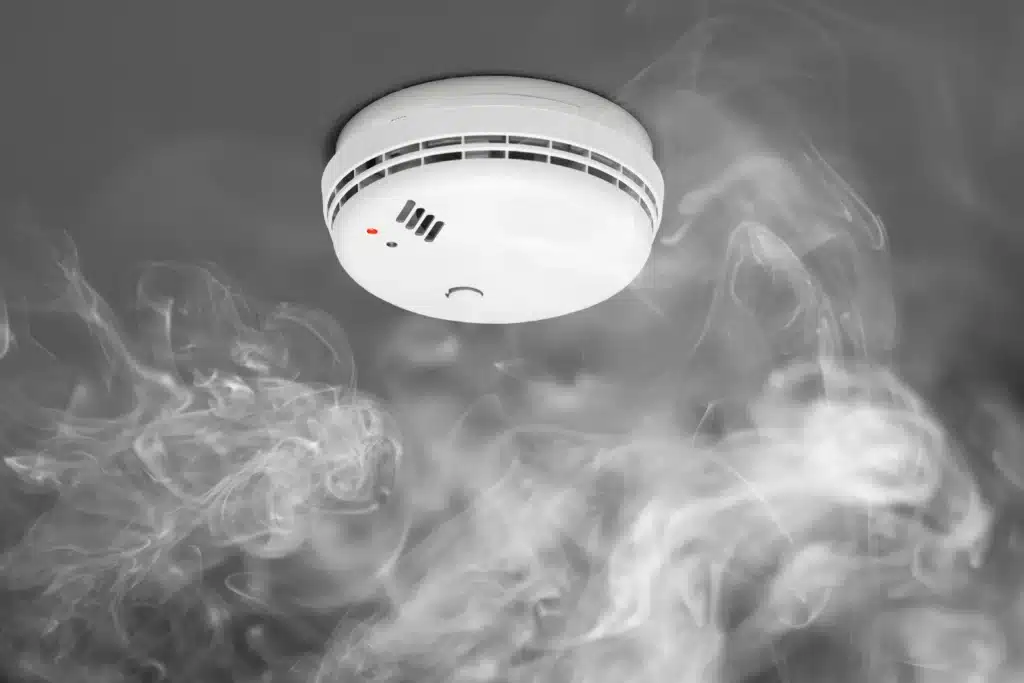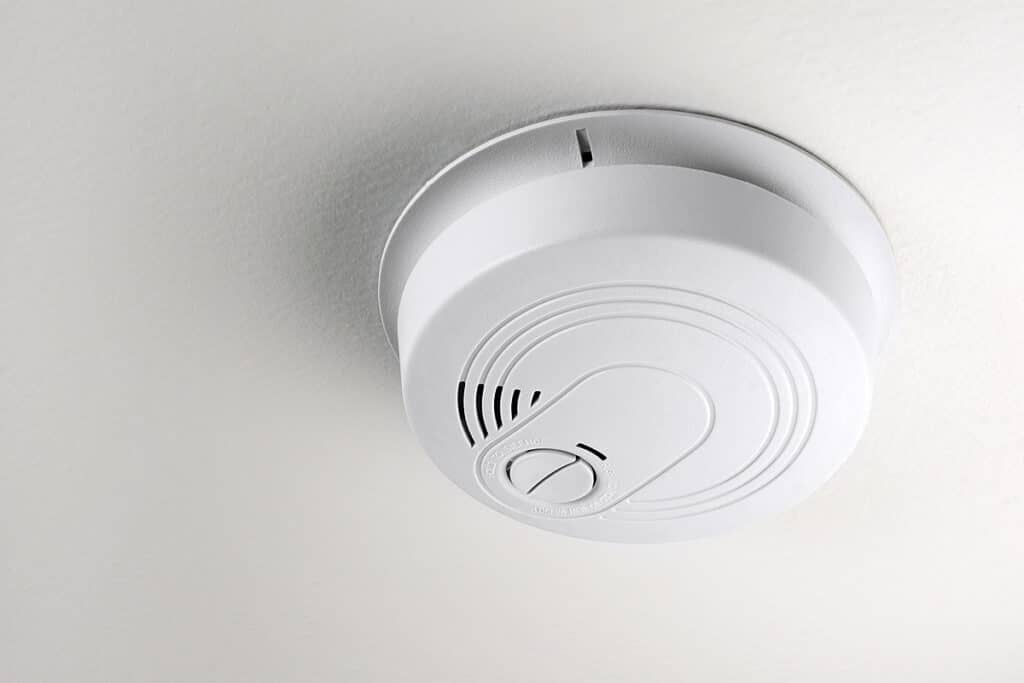Introduction
Where To Place Smoke Detectors: Smoke detectors are an essential component of any home or building’s fire safety system. These devices are designed to detect the presence of smoke in the air and sound an alarm to alert occupants of a potential fire. However, it is not enough to simply have smoke detectors installed in a building; their placement is crucial to ensure maximum effectiveness.
One of the most important factors to consider when determining where to place smoke detectors is the layout of the building. Smoke detectors should be installed in every bedroom, outside each sleeping space, and on every floor. This alerts residents of fires from anywhere. Place smoke detectors near kitchens, fireplaces, and heating appliances where smoke can gather.
Another consideration when placing smoke detectors is the height at which they should be installed. It is recommended that smoke detectors be mounted on the ceiling or high on the wall, as smoke rises and tends to accumulate near the ceiling. This placement allows the detectors to detect smoke as quickly as possible and provide early warning to occupants. To guarantee smoke detectors work, test and maintain them periodically in addition to building layout and height. This includes testing the alarms, replacing batteries, and cleaning them to remove dust and debris that could interfere with their operation.

Where is the best place to put a smoke detector?
When it comes to the safety of your home, one of the most important devices you can have is a smoke detector. These small devices are designed to detect smoke and alert you to the presence of a fire, giving you valuable time to escape. But where is the best place to put a smoke detector in your home?
Some general criteria may help you determine the best smoke detector location for your home, although it depends on its layout and size. Smoke rises, so put your smoke detector on the ceiling or high wall. This speeds up smoke detection.
Also important is installing smoke detectors near bedrooms. Smoke detectors should be near each bedroom because most fires occur at night. This will wake up your family to a fire.
Your home should have smoke alarms on every story and near beds. Include the basement, attic, and any other floors. Fires can be detected anywhere by smoke detectors on every level.
Maintain smoke detectors by inspecting and servicing them. This includes annual battery replacement and device testing. Take these steps to ensure your smoke detectors can alert you to fires at any time.
Where not to put smoke detectors?
Don’t install smoke alarms near windows, doors, or ducts where drafts might interfere with their operation. Never paint smoke alarms. Paint, stickers, or other decorations could keep the alarms from working. For the best protection, interconnect all smoke alarms.
Home safety requires smoke detectors. The smoke detectors warn inhabitants of fire threats. Know where not to set smoke detectors to keep them functional.
Keep smoke detectors away from humid places like bathrooms and kitchens. High humidity might impede smoke detection or produce false alarms. These areas should use heat detectors instead of smoke detectors since they detect rapid temperature rises.
Air ducts should not be near smoke alarms. Airflow from vents can fracture smoke particles and fool the detector. Smoke detectors work best 10 feet from air vents or ducts.
Dusty garages and workshops don’t need smoke alarms. Dust can impede detector sensors, causing false alarms or smoke detection. These places need dust- and dirt-resistant smoke alarms.
Finally, avoid smoke alarms near windows and entrances. These holes can mix smoke particles and prevent them from reaching the detector, slowing or preventing smoke detection. Place smoke alarms 3 feet from doors and windows for best results.
Do you put smoke detectors in every room?
NFPA 72, the National Fire Alarm and Signaling Code, has required smoke alarms in every sleeping room (even existing residences) and outside each sleeping area and on every level for many years. Larger homes need more smoke alarms.
Smoke detectors alert individuals about fire hazards. They alert people to airborne smoke with a loud siren. But placing smoke alarms in every room is controversial.
Some experts advocate smoke detectors in every room for maximum protection. They think room detectors can help people escape faster and that flames can originate anywhere. This method is vital since fires spread quickly in larger structures or multi-level houses.
Some say smoke detectors in every room are superfluous. They believe corridor and communal detectors are sufficient. These are the most likely fire starting or spreading places, so detectors can still alert.
Consider the cost and effort of installing smoke alarms in every room. Smoke alarms need frequent maintenance to perform properly. Monitors in every room of a multi-room house or building might be expensive. Too many gadgets might cause false alarms, which are bothersome and ignored.
Should smoke detector be in bedroom or hallway?
Smoke detector location in the bedroom or hallway is sometimes debated.
Bedroom smoke detectors can detect fires or smoke quickly, when people are most vulnerable. Most home fires occur at night, so a bedroom smoke detector may give you seconds to escape. Children, elderly, and mobility-impaired people must flee quickly.
Advocates of hallway location argue it covers the whole house better. In addition to the bedroom, hallway smoke detectors alert tenants of adjacent rooms. This is important in larger or multi-level homes where fires spread quickly. Hallway smoke detectors help detect fires in living rooms and kitchens, where fires originate more often.
The National Fire Protection Association (NFPA) recommends smoke alarms in every bedroom, outside of every sleeping space, and on every floor, including the basement. This comprehensive strategy discovers fires rapidly and covers the most ground. Installing smoke alarms in the bedroom and hallway can help people locate fires and escape faster.
Should smoke detectors be on wall or ceiling?
One of the most typical smoke detector installation questions is whether to put them on the wall or ceiling. Both solutions have pros and cons, and the choice depends on criteria like space arrangement, smoke detector type, and building code requirements.
Eye-level wall-mounted smoke alarms make testing and repair easy. Smoke rises and gathers here, making the roof easier to spot. Ceiling detectors may fail on steep or vaulted roofs, thus wall-mounted detectors are better.
The best and most prevalent smoke alarms are ceiling-mounted. They can smoke better with greater space. Because cooking and steam smoke may not reach the device, ceiling installation reduces false alarms. Hallway and stairwell ceiling detectors are required by building codes.
Smoke detector location rules vary by jurisdiction and building type. Houses should have smoke detectors on every floor, including the basement and attic. Commercial buildings with detectors in every room and hallway may have stricter standards.
Safe house smoke detector placement is essential. Homes need smoke detectors in bedrooms, living areas, and corridors. Clogged high-risk regions are more prone to catch fire.
Smoke detectors near bedrooms may detect nighttime fires. Smoke rises, thus living room smoke detectors should be on ceilings or high walls away from corners and vents. Hallways need smoke detectors to detect fires immediately, regardless of cause.
What areas of a business building need smoke detectors?
In a commercial building, there are several specific areas where smoke detectors should be installed to ensure maximum safety. These areas include:
- Entrances and Exits: Smoke detectors should be near building entrances and exits. Since people would enter and escape through these places during a fire, early smoke detection can help evacuate the building safely.
- Stairwells: All building stairwells need smoke detectors. Stairwells are generally the main escape route during a fire, thus smoke detectors can warn users.
- Hallways and Corridors: Smoke detectors must be placed in all commercial hallways and corridors. As inhabitants move around the structure, smoke detectors in these spots can detect smoke and notify them to a fire.
How many smoke detectors should be placed in a typical-sized house?
Each level of a typical-sized house should contain at least one smoke detector. This covers the basement, main, and higher floors. Install smoke detectors in each bedroom and sleeping area. In the night, when people are asleep and may not smell or see smoke, this alerts everyone in the house to a fire.
Multiple smoke alarms are very important because they increase the chances of finding a fire early and give people more time to get out of the house. Smoke alarms should be placed in the middle of the ceiling or high on the wall since smoke rises and gathers near it. Also, make sure the smoke alarms are always in good shape by testing and maintaining them regularly and changing the batteries at least once a year.
Are there any specific guidelines for placing smoke detectors in multi-story buildings?
When putting smoke alarms in buildings with more than one floor, it’s important to follow certain rules to make sure everyone is safe. The National Fire Protection Association (NFPA) recommends installing smoke detectors in every room, including the basement and attic. Every bedroom, outside of sleeping areas, and public areas like halls and living rooms should have smoke detectors.
Ceiling height matters in multi-story buildings. The highest point of pitched or slanted ceilings should have smoke detectors within 3 feet. Stairwells should have smoke detectors at the top and landings. Install smoke detectors near kitchens, laundry rooms, and heating equipment to prevent fires.
What are the potential consequences of not properly placing smoke detectors in a building?
Properly placing smoke detectors in a building is crucial for ensuring the safety of its occupants. Failing to do so can have serious consequences in the event of a fire. One potential consequence is the delay in detecting a fire. Smoke detectors detect airborne smoke, which indicates a fire. Not correctly installed smoke detectors may not detect smoke in time, delaying fire response.
Putting smoke alarms in the wrong place increases injury and death risk. Smoke alarms alert people to fires early, allowing them to escape. Smoke alarms in the wrong placements may not alert people of fires in time, increasing the danger of injury or death.

Conclusion
Overall, when it comes to where to place smoke detectors, there are several key factors to consider. First and foremost, it is crucial to have smoke detectors installed on every level of your home, including the basement and attic. This ensures that no matter where a fire may start, the smoke detectors will be able to detect it and alert you and your family in a timely manner. Additionally, it is important to have smoke detectors installed in every bedroom and outside of each sleeping area. This is because fires safety devices can spread quickly, and having smoke detectors in these areas can provide early warning and potentially save lives.
Smoke detector installation near fire sources is also significant. To eliminate false alerts, a kitchen smoke detector should be at least 10 feet away from cooking appliances. Smoke detectors should be at least 10 feet away from bathrooms and other steamy or humid places to avoid false alerts.
To keep your smoke detectors working, examine and service them often. This involves checking the batteries monthly and replacing them as needed and cleaning the detectors to remove dust and debris that could affect their operation. To stay current with technology and standards, smoke detectors should be replaced every 10 years.

